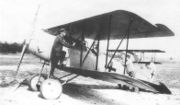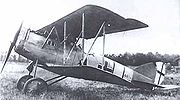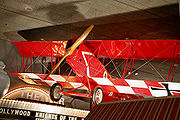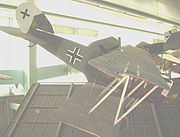
Pfalz D.XII
Encyclopedia
The Pfalz D.XII was a German
Germany
Germany , officially the Federal Republic of Germany , is a federal parliamentary republic in Europe. The country consists of 16 states while the capital and largest city is Berlin. Germany covers an area of 357,021 km2 and has a largely temperate seasonal climate...
fighter aircraft
Fighter aircraft
A fighter aircraft is a military aircraft designed primarily for air-to-air combat with other aircraft, as opposed to a bomber, which is designed primarily to attack ground targets...
built by Pfalz Flugzeugwerke
Pfalz Flugzeugwerke
Pfalz Flugzeugwerke was a World War I German aircraft manufacturer, located at the Speyer airfield in the Palatinate . They are best known for their series of fighters, notably the Pfalz D.III and Pfalz D.XII...
. Designed by Rudolph Gehringer as a successor to the Pfalz D.III
Pfalz D.III
|-See also:-Bibliography:* Gray, Peter and Owen Thetford. German Aircraft of the First World War. London: Putnam, 1962. ISBN 0-93385-271-1.* Grosz, Peter M. Pfalz D.IIIa . Berkhamsted, Herts, UK: Albatros Publications, 1995. ISBN 0-94841-425-1.* Guttman, Jon. Balloon-Busting Aces of World War 1 ...
, the D.XII entered service in significant numbers near the end of the First World War
World War I
World War I , which was predominantly called the World War or the Great War from its occurrence until 1939, and the First World War or World War I thereafter, was a major war centred in Europe that began on 28 July 1914 and lasted until 11 November 1918...
. It was the last Pfalz aircraft to see widespread service. Though the D.XII was an effective fighter aircraft, it was overshadowed by the highly successful Fokker D.VII
Fokker D.VII
The Fokker D.VII was a German World War I fighter aircraft designed by Reinhold Platz of the Fokker-Flugzeugwerke. Germany produced around 3,300 D.VII aircraft in the summer and autumn of 1918. In service, the D.VII quickly proved itself to be a formidable aircraft...
.
Design and development

Idflieg
The Idflieg was the bureau of the German War Office that oversaw German military aviation prior to and during World War I....
(Inspektion der Fliegertruppen) distributed to German aircraft manufacturers a detailed engineering report on the SPAD S.VII
SPAD S.VII
The SPAD S.VII was the first of a series of highly successful biplane fighter aircraft produced by Société Pour L'Aviation et ses Dérivés during the First World War. Like its successors, the S.VII was renowned as a sturdy and rugged aircraft with good climbing and diving characteristics...
, whose wing structure Idflieg considered to be well-designed. Pfalz accordingly produced several Pfalz D.III
Pfalz D.III
|-See also:-Bibliography:* Gray, Peter and Owen Thetford. German Aircraft of the First World War. London: Putnam, 1962. ISBN 0-93385-271-1.* Grosz, Peter M. Pfalz D.IIIa . Berkhamsted, Herts, UK: Albatros Publications, 1995. ISBN 0-94841-425-1.* Guttman, Jon. Balloon-Busting Aces of World War 1 ...
-derived prototypes with SPAD-type wings. These developed into the Pfalz D.XII. The new aircraft was powered by the 180 hp Mercedes D.III
Mercedes D.III
The Mercedes D.III, or F1466 as it was known internally, was a six-cylinder, liquid cooled inline aircraft engine built by Daimler and used on a wide variety of German aircraft during World War I. The initial versions were introduced in 1914 at 160 hp, but a series of changes improved this to...
aü engine and continued Pfalz's Wickelrumpf plywood
Plywood
Plywood is a type of manufactured timber made from thin sheets of wood veneer. It is one of the most widely used wood products. It is flexible, inexpensive, workable, re-usable, and can usually be locally manufactured...
-skinned monocoque
Monocoque
Monocoque is a construction technique that supports structural load by using an object's external skin, as opposed to using an internal frame or truss that is then covered with a non-load-bearing skin or coachwork...
fuselage construction, introduced in the Pfalz D.III. Unlike the earlier aircraft, the D.XII used a two-bay wing cellule. Furthermore, the flush wing radiator was replaced with a car-type radiator mounted in front of the engine. The prototype D.XII first flew in March 1918, subsequently, the Idflieg issued a production order for 50 aircraft.
Pfalz entered several D.XII prototypes in the second fighter competition at Adlershof
Adlershof
-External links:*...
in May/June 1918. Only Ernst Udet
Ernst Udet
Colonel General Ernst Udet was the second-highest scoring German flying ace of World War I. He was one of the youngest aces and was the highest scoring German ace to survive the war . His 62 victories were second only to Manfred von Richthofen, his commander in the Flying Circus...
and Hans Weiss favored the D.XII over the Fokker D.VII, but Udet's opinion carried such weight that Pfalz received substantial production orders for the D.XII. The aircraft passed its Typenprüfung (official type test) on 19 June 1918.
Difficulties with the radiator, which used vertical tubes rather than the more common honeycomb structure, delayed initial deliveries of the D.XII until June. The first 200 production examples could be distinguished by their rectangular fin and rudder. Subsequent aircraft featured a larger, rounded rudder profile.
Operational use


While the D.XII was a marked improvement over the obsolescent Albatros D.V
Albatros D.V
|-See also:-Bibliography:*Bennett, Leon. Gunning for the Red Baron. College Station, TX: Texas A&M University Press, 2006. ISBN 1-58544-507-X....
a and Pfalz D.IIIa, it nevertheless found little favor with German pilots, who strongly preferred the Fokker D.VII. Leutnant Rudolf Stark, commander of Jasta 35, wrote:
Thanks to its sturdy wing and thin airfoil section, the D.XII maintained the excellent high-speed dive characteristics of the earlier Pfalz D.III. Like most contemporary fighters, however, the D.XII had an abrupt stall and a pronounced tendency to spin. Furthermore, pilots consistently criticized the D.XII for its long takeoff run, heavy controls, and "clumsy" handling qualities in the air. Rate of roll, in particular, appears to have been deficient. Landings were difficult because the D.XII tended to float above the ground and the landing gear was weak. Ground crews disliked the extensive wire bracing of the two-bay wings, which required more maintenance than the Fokker D.VII's semi-cantilever wings. Evaluations of captured aircraft by Allied pilots were similarly unfavorable.
Between 750 and 800 D.XII scouts were completed by the Armistice. A substantial number, perhaps as many as 175, were surrendered to the Allies. Of these, a few were shipped to the United States and Canada for evaluation.
Pfalz experimental D types
During the development of the D.XII, Pfalz produced several Pfalz D.IIIPfalz D.III
|-See also:-Bibliography:* Gray, Peter and Owen Thetford. German Aircraft of the First World War. London: Putnam, 1962. ISBN 0-93385-271-1.* Grosz, Peter M. Pfalz D.IIIa . Berkhamsted, Herts, UK: Albatros Publications, 1995. ISBN 0-94841-425-1.* Guttman, Jon. Balloon-Busting Aces of World War 1 ...
-derived prototypes with SPAD-type wings and Windhoff "ear" radiators.
Pfalz D.XIIf
The overcompressed BMW IIIa engine would have provided improved performance in the D.XIIf variant. Records show that Pfalz received 84 such engines between July and October 1918, but there is no photographic evidence of any production D.XII equipped with the BMW IIIa. In his autobiography, Anthony FokkerAnthony Fokker
Anton Herman Gerard "Anthony" Fokker was a Dutch aviation pioneer and an aircraft manufacturer. He is most famous for the fighter aircraft he produced in Germany during the First World War such as the Eindecker monoplanes, the Fokker Triplane the and the Fokker D.VII, but after the collapse of...
claimed that pilots deliberately wrecked D.XIIf aircraft so the engines could be salvaged and installed on Fokker D.VIIs.
Pfalz D.XIV

Survivors

Champlin Fighter Museum
The Champlin Fighter Museum was an aircraft museum located at Mesa, Arizona. It specialized in airworthy World War I and World War II fighters. After 22 years of operation, the Museum was closed on May 26, 2003 and its collection was moved to the Museum of Flight at Seattle's Boeing Field.-External...
, in Mesa, Arizona. The second is exhibited at the National Air and Space Museum
National Air and Space Museum
The National Air and Space Museum of the Smithsonian Institution holds the largest collection of historic aircraft and spacecraft in the world. It was established in 1976. Located in Washington, D.C., United States, it is a center for research into the history and science of aviation and...
, in Washington D.C.
Preserved D.XII aircraft are also displayed at the Musée de l'Air et de l'Espace
Musée de l'Air et de l'Espace
The French Air and Space Museum is a French museum, located in the south-eastern edge of Le Bourget Airport, north of Paris, and in the commune of Le Bourget. It was created in 1919 from a proposition of Albert Caquot .-Description:Occupying over of land and hangars, it is one of the oldest...
in Paris and the Australian War Memorial
Australian War Memorial
The Australian War Memorial is Australia's national memorial to the members of all its armed forces and supporting organisations who have died or participated in the wars of the Commonwealth of Australia...
in Canberra.
Military operators
 German Empire
German Empire
- LuftstreitkräfteLuftstreitkräfteThe Deutsche Luftstreitkräfte , known before October 1916 as Die Fliegertruppen des deutschen Kaiserreiches , or simply Die Fliegertruppen, was the air arm of the Imperial German Army during World War I...
- Polish Air ForcePolish Air ForceThe Polish Air Force is the military Air Force wing of the Polish Armed Forces. Until July 2004 it was officially known as Wojska Lotnicze i Obrony Powietrznej...
(2 aircraft postwar)
Civil operators
 United States
United States
- Paramount PicturesParamount PicturesParamount Pictures Corporation is an American film production and distribution company, located at 5555 Melrose Avenue in Hollywood. Founded in 1912 and currently owned by media conglomerate Viacom, it is America's oldest existing film studio; it is also the last major film studio still...
property manager Louis Kinnell took one airframe to the shops of Chaffee Junior College and restored it to flying condition. This aircraft was kept at Dycer Field (Los AngelesLos ÁngelesLos Ángeles is the capital of the province of Biobío, in the commune of the same name, in Region VIII , in the center-south of Chile. It is located between the Laja and Biobío rivers. The population is 123,445 inhabitants...
, California) and was flown without registration for a short time in 1939.
Specifications


